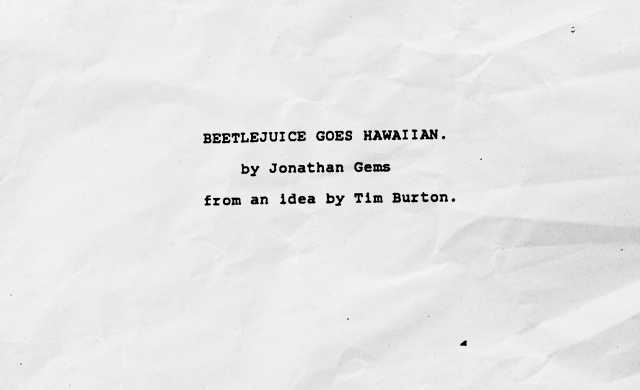We all know about Tim Burton’s comedy-horror hit BEETLEJUICE (1988) and its 36-years-after-the-fact follow-up BEETLEJUICE BEETLEJUICE (2024). That film, FYI, was preceded in the early nineties by two stalled attempts at sequelizing Burton’s film: BEETLEJUICE IN LOVE, scripted by the late Warren Skaaren, and BEETLEJUICE GOES HAWAIIAN. The latter exists in the form of an undated 126-page screenplay by Jonathan Gems, who did an uncredited rewrite on BATMAN (1989) and received sole credit for scripting MARS ATTACKS! (1996). A perusal of BEETLEJUICE GOES HAWAIIAN, “from an idea by Tim Burton,” adequately demonstrates why the proposed film never made it to the screen, although the news isn’t all bad.
As the title indicates, the setting is Hawaii. According to Gems, Burton “thought it would be funny to match the surfing backdrop of a beach movie with some sort of German Expressionism because they’re totally wrong together” (I suspect the setting also had something to do with the old showbiz adage about how when a director wants to vacation somewhere s/he need only make a film set in the desired locale). It’s there that bio-exorcist extraordinaire Beetlejuice (played, as I’m sure you’re aware, by Michael Keaton), who’s given far more screen time here than the 17 minutes he was granted in both BEETLEJUICE and BEETLEJUICE BEETLEJUICE, is summoned.
The summoners are “ancient Hawaiians” whose ancestral home, the tropical island Kanooka, is being developed by the sleazy businessman Charles Deetz (Jeffrey Jones) and his wife Delia (Catherine O’Hara), who previously defiled the haunted house setting of BEETLEJUICE. On Kanooka they’ve built a structure described as “a Las Vegas hotel with a tropical/zoological theme—designed by a New York trendy with a penchant for ‘cute’.”
The Deetzes arrive on the scene with their daughter Lydia (Winona Ryder) and right-hand man Otho, another returnee from the previous film (where he was played by Glenn Shadix). There’s also Kimo, a “good looking Hawaiian” who becomes the love interest for the traumatized Lydia, and a band of environmentally minded beatniks who provide a dose of unsubtle social commentary (had this script been written today it would likely be called woke).
Included are satiric shout-backs to the Beach Party films of the 1960s (already spoofed/updated in 1987’s BACK TO THE BEACH) and a hallucinatory passage set in “INT/EXT. SUBATOMIC UNIVERSE.” The epic denouement involves a tidal wave, sentient dinosaur skeletons, demon statuettes, the Easter Island stone heads and a “Devil’s Ball” in which “All manner of devil, monster, ghoul and freak” cavort—things that, I imagine, would have been extremely difficult to render onscreen with early-nineties special effects technology.
Perhaps unsurprisingly, this script is a royal mess. It foreshadows BEETLEJUICE BEETLEJUICE in its wildly indulgent, overstuffed aesthetic. Whereas BEETLEJUICE was lean and concise, BEETLEJUICE GOES HAWAIIAN revels in excess, with a sprawling, urgency-free narrative drive that exudes manic invention but fails to harness it.
This screenplay can at best be deemed promising. The relationship between Lydia and Beetlejuice, who as you may recall wanted to marry her in BEETLEJUICE, is elaborated on in a convincing and perverse manner. Beetlejuice still aims to wed Lydia, who, under a love spell, actually goes along with Beet’s second attempt at a marriage ceremony. This is an area the more reticent BEETLEJUICE BEETLEJUICE didn’t explore, and in truth neither does BEETLEJUICE GOES HAWAIIAN, but the fact that it brings up the possible consequences of Lydia’s traumatic past earns it a nod from me. With a bit more spit and polish (i.e. a few more drafts) BEETLEJUICE GOES HAWAIIAN could have been a worthwhile endeavor, and one that could have bested BEETLEJUICE BEETLEJUICE.

